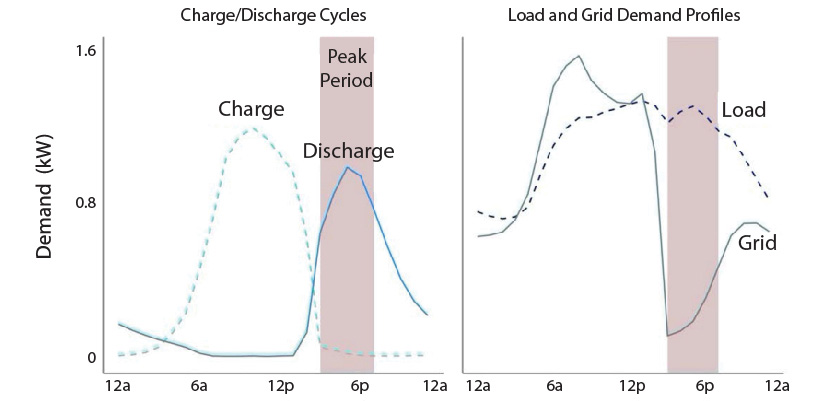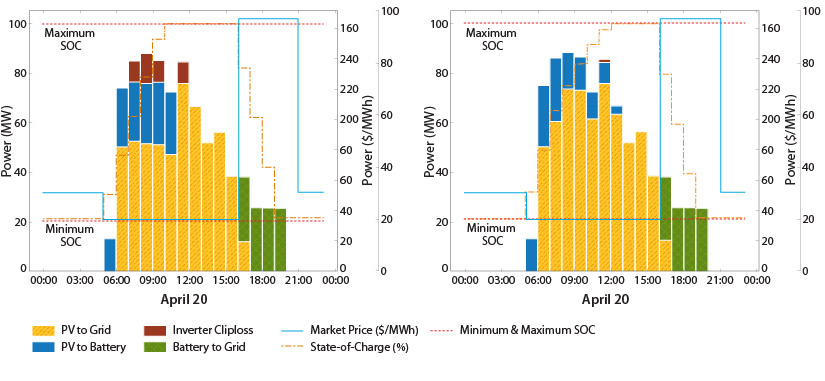Solar-Plus-Storage Analysis
For solar-plus-storage—the pairing of solar photovoltaic (PV) and energy storage technologies—NLR researchers study and quantify the economic and grid impacts of distributed and utility-scale systems.
Much of NLR's current energy storage research is informing solar-plus-storage analysis. Energy storage can provide multiple grid services. It can support grid stability, shift energy from times of peak production to peak consumption, and reduce peak demand. Solar-plus-storage shifts some of the solar system's output to evening and night hours and provides other grid benefits.
NLR employs a variety of analysis approaches to understand the factors that influence solar-plus-storage deployment and how solar-plus-storage will affect energy systems. This work considers both current and future scenarios and can be broadly divided into two market segments—distributed (small-to-medium systems) and utility-scale (large systems).
Distributed Solar-Plus-Storage
Just as PV systems can be installed in small-to-medium-sized installations to serve residential and commercial buildings, so too can energy storage systems—often in the form of lithium-ion batteries. NLR researchers study the benefits of such systems to property owners, their impact on the electric grid, and the effects on how buildings use electricity.
NLR's publicly available System Advisor Model and the Renewable Energy Integration and Optimization Model inform this analytical work.

One NLR study of distributed solar-plus-storage gathered real data from a housing development equipped with solar-plus-storage and compared it with modeled results. This helped the researchers to identify ideal discharge schedules and battery sizes to optimize cost- and emissions savings.
Featured Publications
Savings in Action: Lessons Learned From a Vermont Community With Solar Plus Storage, NLR Technical Report (2024)
Nova Analysis: Holistically Valuing the Contributions of Residential Efficiency, Solar and Storage, NLR Technical Report (2024)
U.S. Solar Photovoltaic System and Energy Storage Cost Benchmarks, With Minimum Sustainable Price Analysis: Q1 2023, NLR Technical Report (2023)
Savings in Action: Lessons From Observed and Modeled Residential Solar Plus Storage Systems
Savings in Action, NLR Technical Report (2022)
Assessing the New Home Market Opportunity: Case Study and Cost Modeling for Solar and Storage in 2030
Assessing the New Home Market Opportunity NLR Technical Report (2022)
Assessing the New Home Market Opportunity NLR Fact Sheet (2022)
Assessing the New Home Market Opportunity NLR Presentation (2022)
Contact
Utility-Scale Solar-Plus-Storage
Energy storage has become an increasingly common component of utility-scale solar energy systems in the United States. Much of NLR's analysis for this market segment focuses on the grid impacts of solar-plus-storage systems, though costs and benefits are also frequently considered.

NLR researchers developed an open-source model to optimize energy storage operation for utility-scale solar-plus-storage systems in both alternating-current-coupled (left) and direct-current-coupled (right) configurations. Here the model was able to demonstrate how the direct-current-coupled battery eliminated the clipping events, and thereby energy loss.
Featured Publications
U.S. Solar Photovoltaic System and Energy Storage Cost Benchmarks, With Minimum Sustainable Price Analysis: Q1 2023, NLR Technical Report (2023)
Exploring The Design Space of PV-Plus-Battery System Configurations Under Evolving Grid Conditions, Applied Energy (2022)
The Evolving Energy and Capacity Value of PV+Battery Hybrid System Architectures, Advances in Applied Energy (2021)
Contact
Storage Futures Study
The Storage Futures Study considered when and where a range of storage technologies are cost-competitive, depending on how they're operated and what services they provide for the grid.
Featured Publications
Economic Potential of Diurnal Storage in the U.S. Power Sector, NLR Technical Report (2021)
Distributed Solar and Storage Outlook: Methodology and Scenarios
Distributed Solar and Storage Outlook NLR Technical Report (2021)
Distributed Solar and Storage Outlook NLR Presentation (2021)
Contact
Share
Last Updated Dec. 7, 2025
